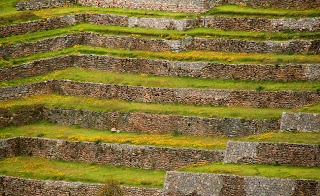"Adventure is what happens when something doesn't go according to plan." is what I wrote near the beginning of this blog. Today was an adventure, and as it turns out, a very good one. I was supposed to have been picked up at my hostel this morning at 10am, brought to the bus station, caught a bus to Ollantaytambo, where I'd pick up a 12:35pm train to Aguas Calientes. It was supposed to be a nice light travel day, I would be just hanging out in Aguas Calientes for the rest of the day, getting settled, and preparing for the trek to Machu Picchu in the early morning.
That didn't happen.
I was picked up from my hostel at more or less the right time, but then my driver informed me that because I had visited the travel agency too late the night before that there were no spaces available on the 12:35pm train. He suggested that he bring me to the bus station anyway, and that I would spend most of the day walking around Ollantaytambo. This did not sound appealing to me at all, especially with a large backpack in tow. I asked him what my other options, and this led to a discussion where eventually we agreed that he would take me on a day tour of several Inca sites between Cuzco and Ollantaytambo. In particular, there were two things I had very much wanted to see, but had written them off as not having enough time. Today I got to see both of those, and that made me very happy. The first was a salt mine. You'd think I'd had my fill of salt after the Bolivian Salt Flats, but no, I felt the need to see more salt.
This salt is mined in a very different way than the salt flats. In this case, there is a natural spring which comes out of the side of a mountain. Even before the Incas showed up, the local population had figured out that this spring was extremely salty, and that they could build terraces in the side of that mountain, and divert the water slowly into these shallow pools. The water fills the pools, then is diverted the next set of pools, and over time each of the 3000 or more pools fills. These are then left to evaporate, leaving several hundred kilos of salt in each of them. The salt on the top is white, it is high grade salt, fit for human consumption. The lower levels of yellow and brown salt are used for various other things, including fattening up cattle. Most of the salt harvested from these ponds is exported to Europe and Japan. I found the mechanism of this all to be pretty fascinating, but even more so, the complex abstract patterns these pools created are very exciting for me as a photographer.
The second area was where the Incas had built a series of concentric circles, ever lower, nestled in large hills. The American archeologist who discovered the site in the early 1920s found that each level had different types of crops that had been planted there. This eventually led the scientific community to believe that this was an experimental area for the Incas, indeed, there is a significant temperature differential as you climb from the top down to the bottom. The Incas did not have a written language, and the Spaniards destroyed much of the Inca culture in the 1500's, so little is known for certain about any of the Inca ruins. It is believed however that his location served as a laboratory where they could test which plants grew well at which temperatures and which altitudes. Given the evidence of Inca knowledge of Astronomy, it would not be too far of a stretch to imagine them conducting these kinds of experiments on their crops.
During the entire day, my guide was extremely knowledgeable and informative. He recently graduated with a degree in tourism, which requires this in depth knowledge, and passing a test which involves pretending that his professors are tourists, taking them to different places, and answering random questions from them. He was very proud to show me his recently acquired government issued tour guide card.
At the end of the day he brought me to Ollantaytambo, where I caught the 7pm train to Aguas Calientes, where I am now typing this blog entry. Once I reach the city, I expect to be picked up by my hostel there, and catch a short night's sleep before getting up early to get to Machu Picchu before the crowds roll in at 10am.
Update: Made it to the hostel. Waiting to meet my guide and then get to sleep as quickly as I can. 4:30am will come very early tomorrow morning.
Ok. The internet here is not being cooperative. I'll upload the rest of today's images tomorrow hopefully.








K, I know you love the more abstract but I really enjoy your pics of people. The incredible intricacy of color and pattern in thier clothing amazes me, too! I also marvel at the stone walls and formations, and the hairpin roads are frightening!
ReplyDeleteThanks Kristina. :) I do love the abstract, and learned how to take photos of people fairly slowly. I'm still much better at candid shots than I am at trying to arrange anyone, put me in a studio and I'd be kind of lost. :) Or, I'd say to the model, "do something interesting!" and they'd look at me funny. Ok, that's actually happened. :) I know that I've had other comments on people photos too, in general they're well liked, so I've been trying to get more. In Bolivia that was impossible, people did not want to be photographed there at all. They did not like it.
Delete